| Pages:
1
2
3 |
Magpie
lab constructor
    
Posts: 5939
Registered: 1-11-2003
Location: USA
Member Is Offline
Mood: Chemistry: the subtle science.
|
|
Preparation of Mononitrotoluenes (o-, p-)
February 22, 2014
This procedure takes ideas from many sources but is principally an adaption of that found in Cumming et al (ref 1), at ½ scale. Since the Cumming
procedure is sparse in detail, and there are some points at which I (and others) have experienced difficulties, I thought that a procedure providing
more guidance would be of value. My difficulties are presented in the Discussion section below.
Attachment: nitrotoluenes.tif (32kB)
This file has been downloaded 2035 times
CAUTION
Nitrotoluenes are poisonous and possibly carcinogenic. NOx vapors are poisonous. Use adequate ventilation and wear gloves.
Excessive temperatures can produce dinitrotoluene and/or trinitrotoluene, which can be explosive. Keep the temperature under 30°C during the acid
addition.
A. Chemicals
50g (57.5 mL) toluene
75g (40.2 mL) con sulfuric acid
75g (50.4 mL) nitric acid (density = 1.44) This was an error on my part. The correct amount of nitric acid is 50g (34.7 mL)
Na2CO3 (or NaHCO3)
petroleum ether (or similar)
B. Equipment
2-neck 250 mL round bottom flask
magnetic stirrer (or other mechanical stirrer)
50° C thermometer
p-e addition funnel (or Pasteur pipette)
separatory funnel
fractional distillation apparatus*
source of vacuum
large ice-water bath (a notched 1-gallon plastic ice cream bucket works well for the bath)
freezer, or -20°C salt bath (82.5 g NaCl + 250g ice)
small Buchner funnel
turkey baster
*my column was 600mm x 12.7mm ID, packed with a ss scrub pad. A shorter column may also be satisfactory.
C. Procedure
1. Setup a 2-neck 250mL RBF in the ice-water bath placed on a magnetic stirrer. Install a p-e addition funnel in the center neck, or leave the
center neck open for use of a Pasteur pipette. Place a magnetic stir bar in the ice-water bath.
2. Install a 50°C thermometer in the side neck.
3. Place a magnetic stir-bar and 57.5mL of toluene in the RBF.
4. Separately prepare an ice-water cooled, mixed acid consisting of 50.4mL of nitric acid and 40.2mL of con sulfuric acid. If not using a Pasteur
pipette place this in the p-e addition funnel (valve closed!). Leave the p-e funnel open to the atmosphere.
5. With the toluene vigorously stirred, run in the mixed acid very slowly. Do not let the temperature rise above 30°C. Maintain
temperature by raising or lowering the water level in the ice-water bath as required. A turkey baster can be used to remove water. The acid addition
will take ½ hour or a little more.
Attachment: phps3rzVS (66kB)
This file has been downloaded 2080 times
all acid added - temperature 13°C
6. After all the acid has been added the temperature is allowed to rise to 50°C (it probably will be necessary to remove the water in the bath.)
This temperature is maintained for 2 hours with the vigorous stirring continued.
Attachment: phpVwHwhO (72kB)
This file has been downloaded 1980 times
2 hr hold at 46°C
Note: The condenser was placed on top of the RBF as shown in the above picture only to contain spattering caused by vigorous stirring.
7. Separate the NT oil from the waste acid using a separatory funnel. The acid will be the bottom layer.
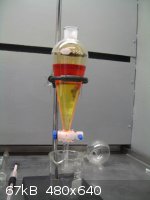
separation of NT and mixed acid
8. Wash the NT with 50mL of water, 50mL of 5% aqueous sodium carbonate, and lastly with 50mL of water. For these washes the NT will be the bottom
layer (density = 1.16).
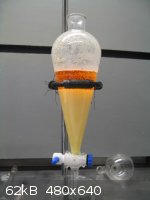
NT plus 1st wash water
Attachment: php2cWEEH (66kB)
This file has been downloaded 1827 times
NT plus 5% Na2CO3 wash water
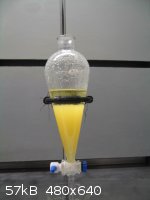
NT plus 2nd wash water
9. Drain the NT into a 125 Erlenmeyer flask, add a scant teaspoon of CaCl2, cork and set aside to dry.
10. The dried NT is then separated from the CaCl2 granules by filtering through a small cotton plug.
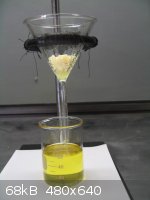
filtering the NT dried over CaCl2
11. Place the dried NT in a freezer set at ~ -20°C. Or use a -20°C salt bath. After freezing, the solid p-nitrotoluene is separated from the
o-nitrotoluene liquid fraction by Buchner funnel filtration. (The Buchner funnel can be pre-cooled in the freezer to minimize any redissolution of the
p-nitrotoluene.) Save the filtrate as it contains the o-nitrotoluene.
p-nitrotoluene (1st batch)
12. Wash the crystals on the filter with a little petroleum ether.
13. Let the crystals dry at room temperature. Determine the melting point. The literature value is 51.7°C. (My yield = 6.7g, mp = 51-52°C)
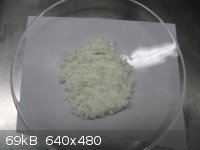
1st batch p-NT crystals
o-nitrotoluene
14. Using a vacuum fractionating column collect the low boiling fraction from the filtrate obtained above. If the pressure is 1mmHg the condensate
will be collected at 60-63°C. This will be o-nitrotoluene.
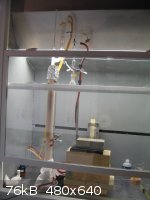
vacuum fractionation apparatus
See next post for procedure continuation.
[Edited on 23-2-2014 by Magpie]
[Edited on 23-2-2014 by Magpie]
[Edited on 23-2-2014 by Magpie]
[Edited on 23-2-2014 by Magpie]
[Edited on 23-2-2014 by Magpie]
[Edited on 23-2-2014 by Magpie]
[Edited on 23-2-2014 by Magpie]
[Edited on 23-2-2014 by Magpie]
[Edited on 23-2-2014 by Magpie]
[Edited on 26-2-2014 by Magpie]
The single most important condition for a successful synthesis is good mixing - Nicodem
|
|
|
Magpie
lab constructor
    
Posts: 5939
Registered: 1-11-2003
Location: USA
Member Is Offline
Mood: Chemistry: the subtle science.
|
|
Preparation of Mononitrotoluenes (o-, p-) (continued)
This is a continuation of the above post.
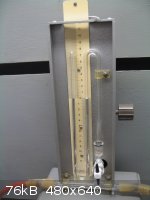
Bennert manometer
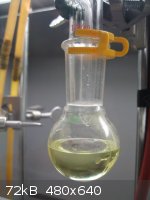
o-nitrotoluene
p-nitrotoluene (2nd batch)
15. The NT remaining in the pot from the fractional distillation is primarily p-nitrotoluene. Freeze this and recover a 2nd batch as prescribed
above. (My yield = 5.8g, mp = 50°C)
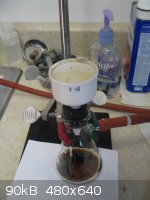
2nd batch of p-nitrotoluene
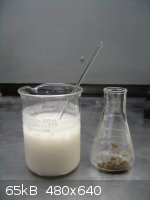
2nd batch of p-nitrotoluene thrown on ice
D. Results
Expected yield (Cumming): almost theoretical
65-70% o-nitrotoluene, ie, 48 - 52g
30% p-nitrotoluene, ie, 22g
4% m-nitrotoluene
author:
o-nitrotoluene yield = 30.6g; % yield = 63.8%
p-nitrotoluene yield = 12.5g; % yield =57.3%
No attempt was made to recover the m-nitrotoluene.
E. Discussion
As indicated above, this preparation can have its difficulties. The first one is that of temperature control during the nitration. On my first
attempt I used a 500mL RBF, did not provide adequate cooling, and ran in the mixed acid too fast. The temperature rose to 45°C during the addition.
In an attempt to reach the 50°C hold temperature I heated with a mantle, overshooting, and the temperature rose to 66°C! During the washing process
a whitish waxy solid appeared and I feared that this was dinitrotoluene, which can be explosive. At that time I aborted the run. In my second run I
took strong measures to keep the temperature under control and consequently it never rose above 14°C during the ½ hr acid addition. Following this
the water in the bath was removed and the temperature came up to 46°C on its own. I then left it unheated/uncooled for the 2 hour hold period. At
no time during the subsequent washes did solids appear.
The second difficulty was that of removing contaminant char from the 2nd batch of p-nitrotoluene. To remove any unreacted toluene from the NT batch
following drying with CaCl2 I attempted to perform a simple distillation. No toluene came over. Instead I created some char, turning my NT batch
black. I must have heated the batch near boiling which would be in the 225-238°C region. The char was tough to remove as the product would oil-out
when dissolving in a 1:1 ethanol:water solvent. I sacrificed a small part of this oil as a char scavenger. The remainder of the NT, dissolved in
about 100mL of the solvent, was thrown onto a beaker of crushed ice. This produced a very fine white solid with a pale yellow cast. Its mp was 50°C
(lit. 51.7°C). Therefore the procedure presented above omits any simple distillation step.
In my attempt to learn more about this synthesis after my first attempt failed, I surveyed what literature I could find including the experiences of
Stefan and Ameisensulfat on versuchschemie.de. A comparison of parameters drawn from this survey is shown in the attached EXCEL file (ref 2).
F. References
1. “Systematic Organic Chemistry,” revised 4th ed, 1950, by Cumming, Hopper, & Wheeler, Preparation 226, p. 277-278. (forum library)
2. EXCEL file comparing parameters:
Attachment: nitrotoluene synthesis parameter comparison.xls (23kB)
This file has been downloaded 1429 times
G. Useful Data
bps:
o-nitrotoluene: 225°C
p-nitrotoluene: 238°C
m-nitrotoluene: 230°C
mps:
p-nitrotoluene: 51.7°C
m-nitrotoluene: 16°C
o-nitrotoluene: -10.6°C (alpha phase); 4.1°C (beta phase)
density:
o-nitrotoluene: 1.163
m-nitrotoluene: 1.157
[Edited on 23-2-2014 by Magpie]
[Edited on 23-2-2014 by Magpie]
[Edited on 23-2-2014 by Magpie]
[Edited on 23-2-2014 by Magpie]
[Edited on 23-2-2014 by Magpie]
[Edited on 26-2-2014 by Magpie]
The single most important condition for a successful synthesis is good mixing - Nicodem
|
|
|
S.C. Wack
bibliomaster
    
Posts: 2419
Registered: 7-5-2004
Location: Cornworld, Central USA
Member Is Offline
Mood: Enhanced
|
|
Systematic Organic Chemistry uses an equal weight of nitric acid and toluene! Maybe the temperature control problem (not that there isn't exotherm
obviously) is from additional nitration. Which is all the more alarming given the later charring and suspected high temperatures:
https://www.sciencemadness.org/whisper/viewthread.php?tid=10...
Although condenser-based launches are impressive and memorable mentally if not physically, it isn't something you want going on in the house.
NaOH washing might be preferable to carbonate:
https://www.sciencemadness.org/whisper/viewthread.php?tid=10...
followed by hydrodistillation, drying, vacuum fractionation.
I haven't bothered to do the math lately, but numbers run much earlier indicated that the standard industrial procedure (equimolar amounts of nitric
acid and toluene or maybe a very slight excess of one or the other, maintaining 25-40C during the acid addition, then rising to 60C) uses a nitrating
mixture of around 28% nitric acid, 16% water, and 56% sulfuric acid, that comes out to 1 part toluene, 1 part 68% nitric acid, and 1.42 parts 96%
sulfuric acid.
|
|
|
Magpie
lab constructor
    
Posts: 5939
Registered: 1-11-2003
Location: USA
Member Is Offline
Mood: Chemistry: the subtle science.
|
|
50g of toluene and 75g of nitric acid are not equal wts. Did you look at the EXCEL spreadsheet - it shows a mole ratio of HNO3/toluene of 1.11.
Quote: Originally posted by S.C. Wack  |
Although condenser-based launches are impressive and memorable mentally if not physically, it isn't something you want going on in the house.
|
If you are referring to the condenser on the RBF I put that on there after all the acid had been added to prevent some spattering due to vigorous
stirring & reflux any acid formed by evolved NOx. I know it is hard to see but that picture was taken in the 2-hr hold period when the
temperature had reached 46°C and I had removed all of the ice-water from the bath. I don't think there was any chance of a temperature excursion at
that point.
The charing did not occur during the nitration. It occured later when I attempted to remove any unreacted toluene by simple distillation.
[Edited on 23-2-2014 by Magpie]
[Edited on 23-2-2014 by Magpie]
[Edited on 23-2-2014 by Magpie]
The single most important condition for a successful synthesis is good mixing - Nicodem
|
|
|
S.C. Wack
bibliomaster
    
Posts: 2419
Registered: 7-5-2004
Location: Cornworld, Central USA
Member Is Offline
Mood: Enhanced
|
|
I probably wouldn't open .xls attachments even if I could at home...and don't care how your condenser is hooked up; didn't even look at your pictures
so sorry, I'm sure it's fine...The condenser mention references what I have seen myself, ergo, what I said...yeah charring during distillation not
nitration "225-238°C region" is exactly what I was thinking about not sounding good...the suggested NaOH washing and steam distillation may eliminate
that, there could be problems if it doesn't...attachment is the relevant Systematic Organic Chemistry pages...equal weights of nitric acid of d 1.44
and toluene are used...
my spreadsheet...
50 g. 68%(69%) nitric acid = 34(34.5) g.
/ 63.01 = .5396(.5475)
+
50 g. toluene / 92.14 = .5427
..equal weight sure does look good for not overnitrating, as long as the acid is added to the toluene with extreme stirring etc...
...maybe no dinitrotoluene is formed using excess nitric acid if the temperature is low enough and there is enough sulfuric acid to compensate for the
water...maybe that isn't how it goes. AFAIK it isn't recommended.
Attachment: cumming nitrotoluene.pdf (118kB)
This file has been downloaded 1354 times
[Edited on 23-2-2014 by S.C. Wack]
|
|
|
Magpie
lab constructor
    
Posts: 5939
Registered: 1-11-2003
Location: USA
Member Is Offline
Mood: Chemistry: the subtle science.
|
|
You are correct! I inadvertantly used 50% too much nitric acid! This is likely the reason I observed so much NO2 being given off during the 2 hour
hold period at 46°C. This may also explain why there was no unreacted toluene.
Just how much dinitrotoluene I made I don't know. It seems, however, not much. I saw no solids during the washes. Also (thankfully) there was no
explosion when I heated the NT up to the 225-238°C region. My first batch of p-NT is quite pure by mp (51-52°C). The 2nd batch was reasonably
pure also by mp (50°C). I can only guess at the purity of my o-NT based on its bp of 60-63°C at P=1mmHg.
As you say a mole ratio of HNO3/toluene of 1.67 is certainly not standard procedure, although not without precedent (Amiesensulfat, Davis). I will
flag this error in my procedure. Thank you for pointing it out!
[Edited on 23-2-2014 by Magpie]
[Edited on 23-2-2014 by Magpie]
The single most important condition for a successful synthesis is good mixing - Nicodem
|
|
|
DJF90
International Hazard
    
Posts: 2266
Registered: 15-12-2007
Location: At the bench
Member Is Offline
Mood: No Mood
|
|
I really like that you've documented this as I've been wanting to do this for a long time now. I could not find any previous attempt that detailed the
separation of the o- and p-nitro toluenes. I'd suggest however that you re-crystallise your p-nitrotoluene to ensure it is
free from any m-nitrotoluene.
As a side note I find p-nitrotoluene has a pleasant cherry/almond odour reminiscent of benzaldehyde or piperonal. The two nitrotoluenes
you've obtained are useful substrates for further elaboration and other interesting projects.
Let me finish by congratulating you on your success.
|
|
|
Magpie
lab constructor
    
Posts: 5939
Registered: 1-11-2003
Location: USA
Member Is Offline
Mood: Chemistry: the subtle science.
|
|
Thanks. I think the reason we haven't seen any posts on isolation of the o- isomer is that the bp difference between the o- and p- isomers is only
about 13°C. This is a challenge for fractional distillation unless you have a sufficiently long column.
In the thread referenced above by S.C.Wack I believe garage chemist mentions that he attempted a vacuum fractionation but ran into column flooding
problems. I too had some flooding but backed off on the heat and it seemed to go away. I couldn't really tell what was going on in the column,
except at the top, because I had the column fully insulated. GC then said he tried fractionation at normal pressure. But this would require
temperatures in the 225-238°C region where I experienced severe charing.
It was also brought out in this thread, I believe, that if residual toluene (if any) is not removed from the NT product the p- isomer will not
crystallize out properly by freezing.
I regret that I inadvertantly used 50% too much nitric acid. But I still wanted to post the results as I felt that they would be useful to others.
[Edited on 26-2-2014 by Magpie]
The single most important condition for a successful synthesis is good mixing - Nicodem
|
|
|
AvBaeyer
National Hazard
   
Posts: 655
Registered: 25-2-2014
Location: CA
Member Is Offline
Mood: No Mood
|
|
The predominance of the ortho-isomer is a very useful outcome as it is a good starting point for heterocycles such as indoles and quinolines. From an
old retired chemist, nice job!
|
|
|
Magpie
lab constructor
    
Posts: 5939
Registered: 1-11-2003
Location: USA
Member Is Offline
Mood: Chemistry: the subtle science.
|
|
Thank you AvBaeyer and welcome to the forum.
The single most important condition for a successful synthesis is good mixing - Nicodem
|
|
|
smaerd
International Hazard
    
Posts: 1262
Registered: 23-1-2010
Member Is Offline
Mood: hmm...
|
|
Fantastic job. What kind of vacuum fractionating column is that?
|
|
|
Magpie
lab constructor
    
Posts: 5939
Registered: 1-11-2003
Location: USA
Member Is Offline
Mood: Chemistry: the subtle science.
|
|
Thank you. My column is 600mm x 12.7mm ID, packed with a ss scrub pad. It is a Hempel column with ground glass end fittings. This is available from
Eagle Scientific Glass. At the top of the column is mounted a Hennion type still head which allows control of the reflux ratio.
[Edited on 23-3-2014 by Magpie]
The single most important condition for a successful synthesis is good mixing - Nicodem
|
|
|
Waffles SS
Fighter
   
Posts: 998
Registered: 7-12-2009
Member Is Offline
|
|
That is great Magpie.
I have some questions:
How you provide 1mmhg(do you use diaphragm vacuum pump or double stage oil vacuum?)
This is possible to separate O isomer only by Fractional crystallization ?
|
|
|
Magpie
lab constructor
    
Posts: 5939
Registered: 1-11-2003
Location: USA
Member Is Offline
Mood: Chemistry: the subtle science.
|
|
Quote: Originally posted by Waffles SS  |
How you provide 1mmhg(do you use diaphragm vacuum pump or double stage oil vacuum?)
This is possible to separate O isomer only by Fractional crystallization ? |
My vacuum pump is merely a one-stage oil pump: a $100 cheap pump from Harbor Freight. I, too, am a little surprised that it pulls such a good vacuum.
I think one procedure says that by removing the p-isomer by repeated crystallizations the remaining component is essentially the o-isomer. Then by
steam distillation the p-isomer can be separated from the small amount of m-isomer. I would have to go back and find that procedure to confirm this,
however.
---------------------------------------------------------------------------
Edit: The procedure I was referring to can be found in the forum library, as was pointed out by garage chemist. It is the book on TNT by G. Carlton
Smith. Here is the excerpt that provides for separation of o- and p-nitrotoluenes without the use of fractional distillation:
"A possibly better method of separating the isomeric
mononitrotoluenes is one used by the firm of Meister,
Lucius & Bruning. This consists in cooling the
mixed nitrotoluenes to —4 to —10 °C and removing
the liquid portion after about one-half the mixture has
crystallized. The separation may be effected by a
centrifuge. The liquid obtained by one crystallization
is practically pure ortho nitrotoluene. The resulting
mixture of meta and para nitrotoluenes may be
separated by steam distillation. The para is very
volatile with steam, while the meta is but slightly so."
I have not tried this. Basically I went right to vacuum fractional distillation based on the experience of garage chemist.
[Edited on 25-3-2014 by Magpie]
[Edited on 25-3-2014 by Magpie]
The single most important condition for a successful synthesis is good mixing - Nicodem
|
|
|
CuReUS
National Hazard
   
Posts: 928
Registered: 9-9-2014
Member Is Offline
Mood: No Mood
|
|
magpie
could we increase the yield of the ortho isomer by sulphonating toluene first(oleum or boiling in sulphuric acid for sometime) and then adding nitric
acid only, to the mix(no need to extract the p-methylsuphonic acid),the extra sulphuric acid will help form nitroniu ion and help in nitration
mostly while sulphonating toluene ,the -HSO3 will go to para ,but even if it goes to ortho
the -NO2 will enter the ring otho to the methyl group rather than going near to -HSO3(those two are the positions available due to meta directing
nature of -HSO3)
or will the -HSO3 group get substituted for -NO2
also can para-methyl sulphonic acid be alkylated using friedel craft
|
|
|
Metacelsus
International Hazard
    
Posts: 2543
Registered: 26-12-2012
Location: Boston, MA
Member Is Offline
Mood: Double, double, toil and trouble
|
|
Sulphonic acids are strongly deactivating. Friedel-Crafts alkylation will fail.
|
|
|
careysub
International Hazard
    
Posts: 1339
Registered: 4-8-2014
Location: Coastal Sage Scrub Biome
Member Is Offline
Mood: Lowest quantum state
|
|
Quote: Originally posted by Magpie  | Quote: Originally posted by Waffles SS  |
How you provide 1mmhg(do you use diaphragm vacuum pump or double stage oil vacuum?)
This is possible to separate O isomer only by Fractional crystallization ? |
My vacuum pump is merely a one-stage oil pump: a $100 cheap pump from Harbor Freight. I, too, am a little surprised that it pulls such a good vacuum.
[Edited on 25-3-2014 by Magpie] |
According to the HF website it is good to 0.075 torr. I have been looking at the HF two stage for vacuum distillations (and a little carbon fiber
vacuum bagging) which is good to 0.022 torr.
I think this mononitration can be done with really cheap reagents - drain cleaner acid (94% H2SO4) and fertilizer KNO3. This would make optimization
for position selectivity moot, just crank out a larger batch.
|
|
|
Magpie
lab constructor
    
Posts: 5939
Registered: 1-11-2003
Location: USA
Member Is Offline
Mood: Chemistry: the subtle science.
|
|
CuReUS: I would not want to speculate on the efficacy of your proposed scheme as I do not know that much about it. But how do you propose to remove
those extraneous -HSO3 groups following the nitration?
I agree with careysub and would just make a larger batch. Your approach just seems like unnecessary complication. Like many organic syntheses the
devil is in the separation of product from by-products and unreacted reactants.
The single most important condition for a successful synthesis is good mixing - Nicodem
|
|
|
CuReUS
National Hazard
   
Posts: 928
Registered: 9-9-2014
Member Is Offline
Mood: No Mood
|
|
magpie -actually removal of the sulpho group is very easy and the sulphonation process is actually reversible
read this under mechanism http://en.wikipedia.org/wiki/Aromatic_sulfonation
they talk about how to remove the -HSO3
cheddite cheese -i agree that sulphonic acid is deactivating,that's why i have put a methyl group ,are you saying it will still fail
|
|
|
Metacelsus
International Hazard
    
Posts: 2543
Registered: 26-12-2012
Location: Boston, MA
Member Is Offline
Mood: Double, double, toil and trouble
|
|
Yes. The sulphonic acid is a much stronger deactivator than the methyl group is an activator.
|
|
|
CuReUS
National Hazard
   
Posts: 928
Registered: 9-9-2014
Member Is Offline
Mood: No Mood
|
|
i dont want to ask this ,but since alkylation will fail ,acylation will also definitely fail?
what about a gatterman-koche reaction of the p-methylsulphonic acid
gatterman -koche reaction http://en.wikipedia.org/wiki/Gattermann_reaction
|
|
|
DJF90
International Hazard
    
Posts: 2266
Registered: 15-12-2007
Location: At the bench
Member Is Offline
Mood: No Mood
|
|
I've looked into doing just as you suggest, Careysub, and previously found an old reference for the nitration of p-toluenesulfonic acid. I don't
recall the details though I have the paper saved on my pc at home. Other reaxys results used TsCl as the substrate, but that is less friendly. The
idea was to improve the selectivity for o-nitration as it would be required in a larger quantity than the p-nitrotoluene, although
both are useful and interesting.
|
|
|
careysub
International Hazard
    
Posts: 1339
Registered: 4-8-2014
Location: Coastal Sage Scrub Biome
Member Is Offline
Mood: Lowest quantum state
|
|
CuReS
Hmm... I could have done the "Breaking Bad" thing with my username here and be known as CaReYSUB.
Oh well.

|
|
|
CuReUS
National Hazard
   
Posts: 928
Registered: 9-9-2014
Member Is Offline
Mood: No Mood
|
|
DJF90
so nitration on sulphonated ring is possible .but while sulphonating wont the sulpho group go to ortho as well as para position because the methyl
group is not such a bulky molecule?
careysub
yes ,Br Ba was the best show there WAs,there IS and there will B (you could also use Be ) )
|
|
|
Metacelsus
International Hazard
    
Posts: 2543
Registered: 26-12-2012
Location: Boston, MA
Member Is Offline
Mood: Double, double, toil and trouble
|
|
I think I'll give this a try, on a larger scale. I plan to use 200 g nitric acid (135 mL), 300 g sulfuric acid (165 mL), and 200 g toluene (230 mL).
Because of the greater scale, I will add the acids very slowly to keep the temperature down.
I'm adding the acid at a rate of roughly 1 drop per second. I will try to keep the temperature below 20 C at all times. It currently is at 15.
The addition of the acid is finally complete (total time 4 hours 10 minutes). I will let it react for another half hour, then collect the product. The
maximum observed temperature was 27 C (my ice ran out); not ideal, but acceptable.
First crop of p-nitrotoluene crystals: 28.7 g. 225 mL of nitrotoluene mixture remains.
Yield of o-nitrotoluene after fractionation (fraction 65-70 C): 128.1 g. I was using the same type of Harbor Freight single stage pump that Magpie
used, actually.
I'm freezing the remaining portion to recover more p-nitrotoluene.
I got 10.1 more grams of p-nitrotoluene.
[Edited on 26-10-2014 by Cheddite Cheese]
|
|
|
| Pages:
1
2
3 |